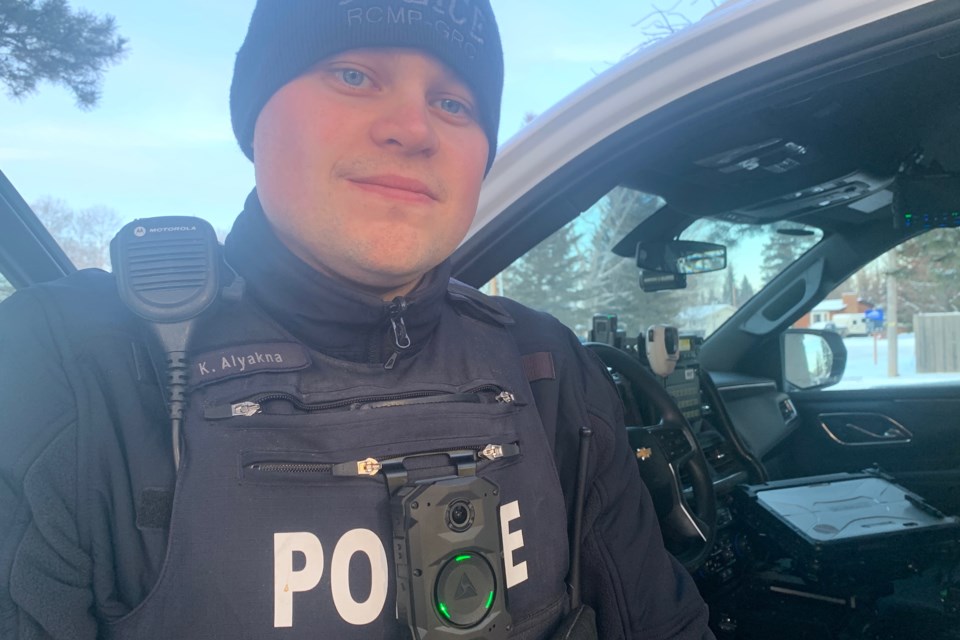Sundre, Didsbury and Olds RCMP are now among the frontline officers who are officially equipped with body-worn cameras and using them as part of the RCMP’s ongoing commitment to transparency, accountability, and modernization.
“Following comprehensive training, (Sundre) officers are now ready to use this cutting-edge technology while serving their communities,” Cpl. Courtney Harding told the Albertan by email last week.
“Our training took place in Olds from February 3-5, with RCMP members from Three Hills, Didsbury, Sundre and Olds detachments taking part,” said Harding, adding the initiative is part of a 12-month nationwide rollout of body-worn cameras that began this past fall.
The majority of Didsbury RCMP officers received the training, confirmed Didsbury RCMP detachment's commanding officer, adding those who received the training are using the new technology in the field.
Olds RCMP members who were trained are also using the cameras.
“With any implementation of any new technology, it will take some time but not a lot of time for the members to get used to using them in the course of their duties,” noted Staff Sgt. Warren Wright who is the commanding officer of the Olds RCMP detachment.
WATCH: How and when body-worn cameras are used and why:
Source: RCMP video
Const. Kirill Alyakna, one of the members at the Sundre detachment, offered his thoughts before starting an evening shift on Thursday, Feb. 6.
“The first day I got trained, I went out and did a little bit of traffic (enforcement) and just put it in use for myself to get used to it,” he said.
During the training sessions there were some questions brought up in relation to disclosures, “but for the most part in my opinion, this is awesome,” he said.
“Every time you interact with an officer, the officer’s going to let you know that you’re (being) audio-video recorded unless we are legally placed at the scene.”
A green display indicates the device is not recording while a red display means it has been activated, although video recordings begin 30 seconds prior to the camera being turned on, he said.
“We have to let people know that they are video and audio recorded,” he emphasized.
“It all comes down to transparency. If that’s what policing comes down to, I have no issues wearing the body-worn camera,” he said.
And if the device helps with investigations or even resolve public complaints, “that’s I think the benefit of this body-worn camera,” he added.
“If that’s what offers you safeguards as an officer, I think it’s amazing.”
Although new to the RCMP, body-worn cameras have already been used by police agencies throughout North America for a long time, he said.
In the first interactions he experienced after starting to use the body-worn camera, Alyakna said he observed people adjusting their conduct.
“I feel like people change their behaviour as soon as I mention that they are video and audio recorded,” the constable said.
“Maybe they tend to understand now that this is real business; this is a real interaction that can be played in court if that’s necessary or can be used as evidence,” he said.
“I’m all for it and I’m glad that I got it.”
Harding previously told the Town of Sundre council that the cameras will be used when initiating contact with a member of the public, whether for the purpose of an investigation, a crime in progress, a mental health call, public disorder or even traffic stops.
Council also heard at the time that the cameras are not intended to be used for 24-hour recording or surveillance and covert operations, nor are the devices to be used during strip or body cavity searches and areas with high expectation of privacy unless there are extenuating circumstances.
According to a Q&A provided by the RCMP, the public will be able to ask an officer to turn their camera off in certain circumstances according to policy.
In situations where there are concerns for police or public safety or the video has investigational value, the policy requires RCMP officers to keep the camera on.
"The RCMP's policy was also developed with the needs of victims in mind. It requires that RCMP officers be aware of the impact that recordings may have on individuals involved in incidents of a sensitive nature. In such cases, RCMP officers may temporarily obstruct the video to protect the privacy of another person. When this occurs, RCMP officers are required to provide a rationale as part of the recording or in their notebook," the RCMP's Q&A says.
Approximately 10,000 to 15,000 cameras are being deployed to frontline officers throughout the country, with detachments in Alberta at the forefront, she said.
The devices have increasingly been used by police agencies worldwide for their ability to provide accurate, unbiased audio-video documentation of police interactions, she said.
“Your Alberta RCMP is proud to implement this technology to meet the ever-changing policing needs of Albertans and uphold public safety.”
The corporal cited the following as key benefits of body-worn cameras:
• Enhanced accountability and public trust – video evidence collected will provide an independent and objective way to capture interactions between the community and officers.
• Improved police-community interactions – cameras encourage respectful encounters and reduce tensions.
• Better evidence collection – high-quality audio and video footage supports investigations and prosecutions.
• Efficient complaint resolution – objective records expedite investigations, saving time and resources.



